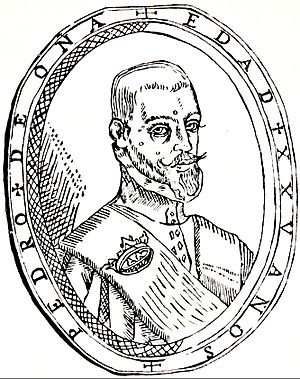Pedro de Oña facts for kids
Pedro de Oña (born 1570, died 1643) was a very important poet. Many people consider him the first well-known poet born in Chile. He is most famous for his long poem called Primera parte de Arauco domado. This title means "First Part of the Araucan Conquest."
Pedro de Oña was born in a place called Angol. His father, Gregorio de Oña, was a military captain. Sadly, his father died during Spain's conquest of Chile. Pedro grew up during these challenging times. He lived in a small military town. This area was mostly controlled by the native people of Chile.
Contents
Pedro de Oña's Early Life and Studies
Pedro de Oña's mother married again. Her new husband was an important person. This allowed Pedro to get a good education. He studied in Lima, a big city in Peru.
First, he went to the Real Colegio de San Martín. Later, he attended the Universidad de San Marcos. In 1596, he earned his bachelor's degree in Lima. He learned from many famous writers from the past. He also worked at different jobs in Peru.
The Epic Poem: Arauco Domado
In 1596, Pedro de Oña published his most famous work, Arauco domado. This was a long, epic poem. It was written in rhyming pairs of lines. The poem praised the military actions of García Hurtado de Mendoza, 5th Marquis of Cañete. He was a powerful leader, like a governor, in Peru.
It seems that Hurtado de Mendoza was not happy with how he was shown in another poem. That poem was called La Araucana by Alonso de Ercilla y Zúñiga. So, he asked Pedro de Oña to write a new one.
Pedro de Oña looked at famous poems for ideas. He studied Aeneid by Virgil. He also looked at Ercilla's work. Ercilla's poem praised the bravery of the native people. But De Oña's poem praised his patron, Hurtado de Mendoza.
Arauco domado has 20 parts, called cantos. It tells exciting stories. These include the Battle of Bío-Bío. It also talks about a rebellion in Quito against tax collectors. Another part describes a sea battle. This was between a pirate named Richarte Aquines (who was Richard Hawkins) and Don Beltrán de Castro.
In the poem, De Oña describes the Mapuches people. He also shares information about their traditions and customs. He writes about other native groups too.
Challenges and Other Writings
When his patron, Hurtado de Mendoza, left Peru, some people tried to hurt Pedro de Oña's career. They banned his poem, Arauco domado. They also accused him of writing things that the archbishop of Lima thought were harmful.
Pedro de Oña wrote other works too. These include Temblor de Lima de 1609, which was about an earthquake. He also wrote El Vasauro and a religious poem called Ignacio de Cantabria.
Later in his life, Pedro de Oña faced difficulties. His wife died, and he had five children to care for. He lived in poverty for the rest of his life.
See also
 In Spanish: Pedro de Oña para niños
In Spanish: Pedro de Oña para niños


